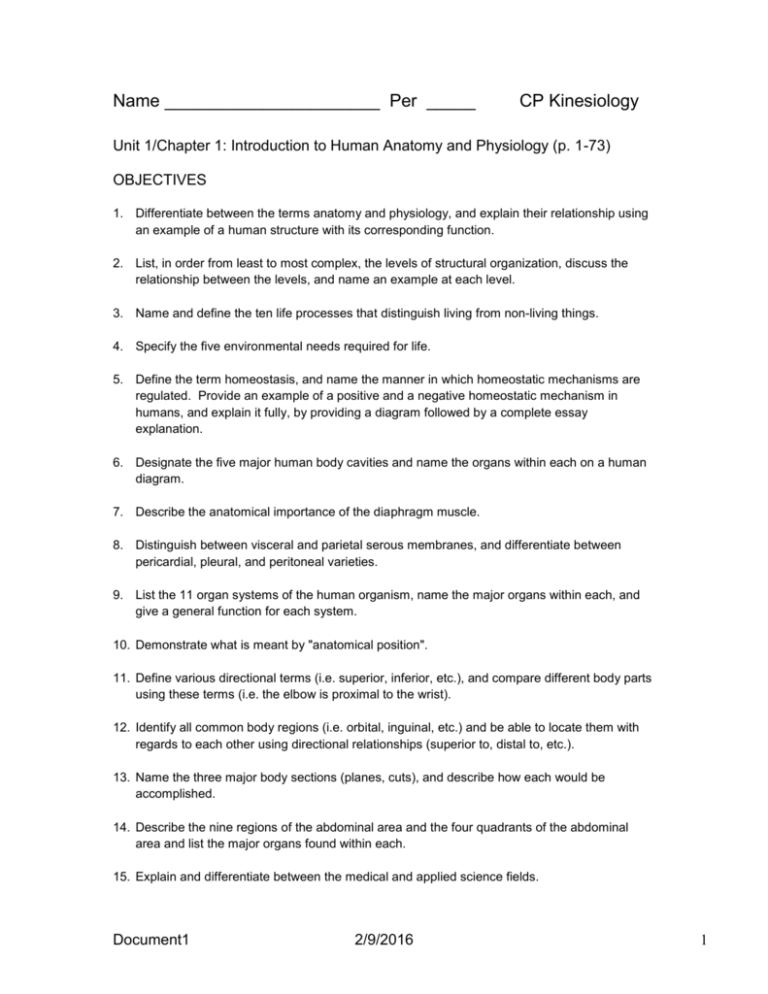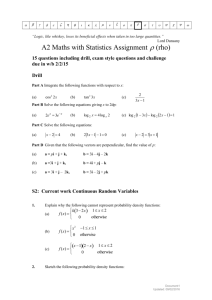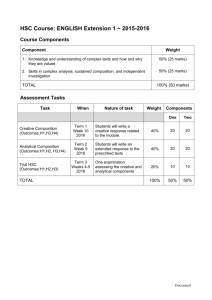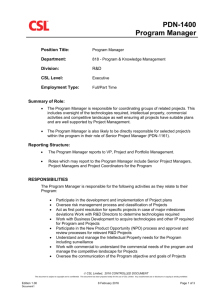Chapter One: Introduction to
advertisement

Name ______________________ Per _____ CP Kinesiology Unit 1/Chapter 1: Introduction to Human Anatomy and Physiology (p. 1-73) OBJECTIVES 1. Differentiate between the terms anatomy and physiology, and explain their relationship using an example of a human structure with its corresponding function. 2. List, in order from least to most complex, the levels of structural organization, discuss the relationship between the levels, and name an example at each level. 3. Name and define the ten life processes that distinguish living from non-living things. 4. Specify the five environmental needs required for life. 5. Define the term homeostasis, and name the manner in which homeostatic mechanisms are regulated. Provide an example of a positive and a negative homeostatic mechanism in humans, and explain it fully, by providing a diagram followed by a complete essay explanation. 6. Designate the five major human body cavities and name the organs within each on a human diagram. 7. Describe the anatomical importance of the diaphragm muscle. 8. Distinguish between visceral and parietal serous membranes, and differentiate between pericardial, pleural, and peritoneal varieties. 9. List the 11 organ systems of the human organism, name the major organs within each, and give a general function for each system. 10. Demonstrate what is meant by "anatomical position". 11. Define various directional terms (i.e. superior, inferior, etc.), and compare different body parts using these terms (i.e. the elbow is proximal to the wrist). 12. Identify all common body regions (i.e. orbital, inguinal, etc.) and be able to locate them with regards to each other using directional relationships (superior to, distal to, etc.). 13. Name the three major body sections (planes, cuts), and describe how each would be accomplished. 14. Describe the nine regions of the abdominal area and the four quadrants of the abdominal area and list the major organs found within each. 15. Explain and differentiate between the medical and applied science fields. Document1 2/9/2016 1 1. Understanding Words (p. 1: define, give an example and explain): AppendCardiCerebrCranDorsHomeo-logy MetaNasOrbParietPelvPeriPleur-stasis Super-tomy Document1 2/9/2016 2 Directions: for the remainder of this packet, either explain/summarize the term or sketch the diagram as directed. 2. Anatomy and Physiology (p. 4) anatomy physiology 3. Levels of Organization (p. 4-6) subatomic particles atom molecule macromolecule organelle cell tissue organ organ system organism Document1 2/9/2016 3 4. Characteristics of Life (p. 6-8) movement responsiveness growth reproduction respiration digestion absorption circulation assimilation excretion metabolism (anabolism and catabolism) 5. Requirements of Organisms (p. 8-9) water food oxygen heat pressure atmospheric pressure hydrostatic pressure Document1 2/9/2016 4 6. Homeostasis (p. 9-10) homeostasis homeostatic mechanisms receptor control center/set-point effector negative feedback Sketch Fig 1.6 on p. 10 (Homeostatic mechanism) Sketch Fig 1.7 on p. 11 (Room temperature) Document1 2/9/2016 5 7. Body Cavities (p. 12) The following are major cavities (spaces) found throughout the human body: cranial cavity spinal (vertebral) cavity thoracic cavity abdominopelvic cavity diaphragm mediastinum abdominal cavity pelvic cavity oral cavity nasal cavity orbital cavity middle ear cavity sketch-out Figure 1.9a and b (p. 13) Document1 2/9/2016 6 8. Organ Systems (p. 15-20, Fig 1.19 on p. 20). List the 11 organ systems, name the major organs in each system and give a general function for each system: 1. 2. 3. 4. 5. 6. 7. 8. 9. 10. 11. Document1 2/9/2016 7 9. Relative position (p. 21) anatomical position superior inferior anterior posterior medial lateral ipsilateral contralateral proximal distal superficial peripheral deep Document1 2/9/2016 8 10. Body Sections/Slices (p. 21-23) These “slices” are 3 ways to view the ENTIRE human body: sagittal transverse coronal (frontal) sketch-out Figure 1.20 (p. 22) These “slices” are 3 ways to view a BONE OR OTHER LONG STRUCTURE within the human body: Cylindrical Sections (p. 23) cross section oblique section longitudinal section sketch-out Figure 1.22 (p. 23) Document1 2/9/2016 9 11. Body Regions Part 1 (p. 23-25) These regions describe areas of the abdominopelvic region: epigastric left and right hypochondriac umbilical left and right lumbar hypogastric left and right iliac (inguinal) RUQ RLQ LUQ LLQ Sketch-out Figure 1.23a,b (p. 23) Document1 2/9/2016 10 12. Body Regions Part 2 (p. 23-25) These 43 regions are the terms we use to describe various areas on/within the human body: 12.1. abdominal 12.2. acromial 12.3. antebrachial 12.4. antecubital 12.5. axillary 12.6. brachial 12.7. buccal 12.8. carpal 12.9. celiac 12.10. cephalic 12.11. cervical 12.12. costal 12.13. coxal 12.14. crural 12.15. cubital 12.16. digital 12.17. dorsum 12.18. femoral 12.19. frontal 12.20. genital 12.21. gluteal Document1 2/9/2016 11 12.22. inguinal 12.23. lumbar 12.24. mammary 12.25. mental 12.26. nasal 12.27. occipital 12.28. oral 12.29. orbital 12.30. otic 12.31. palmar 12.32. patellar 12.33. pectoral 12.34. pedal 12.35. pelvic 12.36. perineal 12.37. plantar 12.38. popliteal 12.39. sacral 12.40. sternal 12.41. tarsal 12.42. umbilical 12.43. vertebral Document1 2/9/2016 12 13. Medical and applied science terms (p. 25) The following terms are fields of medicine: 13.1. cardiology 13.2. dermatology 13.3. endocrinology 13.4. epidemiology 13.5. gastroenterology 13.6. geriatrics 13.7. gerontology 13.8. gynecology 13.9. hematology 13.10. histology 13.11. immunology 13.12. neonatology 13.13. nephrology 13.14. neurology 13.15. obstetrics 13.16. oncology 13.17. ophthalomology 13.18. orthopedics 13.19. otolaryngology 13.20. pathology 13.21. pediatrics 13.22. pharmacology Document1 2/9/2016 13 13.23. podiatry 13.24. psychiatry 13.25. radiology 13.26. toxicology 13.27. urology Document1 2/9/2016 14









